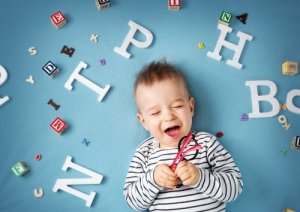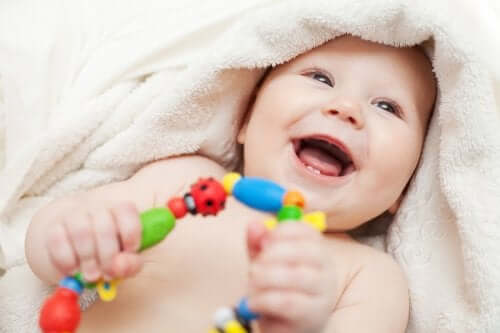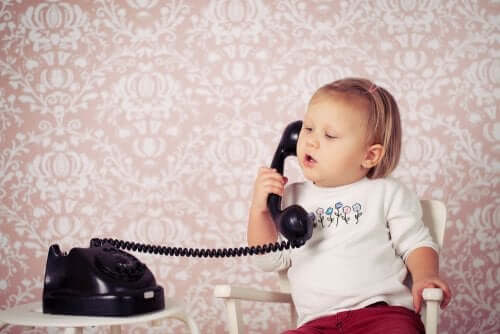The Development of Language in Babies

Language helps us communicate, but the development of language in babies is a long and complex process. Today we’ll take a close look at this process, which begins in early childhood.
Language is a set of shared norms that allow for the expression of ideas in a logical manner. This definition comes from the National Institute on Deafness and Other Communication Disorders (NIDCD).
From the time children are born, they begin to babble. By the time babies reach their first birthday, most say their first words.
“The purpose of language is to give a final shape to thought; to prepare it for intellectual activity, while indicating the social nature of man’s intellectual activity, an act that radically distinguishes man from animal.”
– Luria –
The development of language in babies
From birth to 6 months
- Turn their heads towards sounds.
- Respond to changes in tone of voice.
- Listen to music attentively.

By the time babies reach 6 months of age, most are able to recognize the basic sounds of their mother’s language. Furthermore, over the course of this stage, babies begin to babble, gurgle, laugh and reproduce speech-like sounds.
From 6 to 12 months of age
Once children can identify and produce sounds in a consistent way, their communication becomes more elaborate. Therefore, we can observe the following actions in babies between the ages of 6 and 12 months:
- Listening when others speak to them.
- Understanding frequent and common words in their mother tongue.
- Responding to verbal requests.
- Babbling long and short groups of sounds.
- Babbling in order to call the attention of others.
- Communication through gestures.
- The imitation of certain sounds from speech.
- The use of language to ask for things or express feelings, protests, acceptance, etc.
- The pronunciation of their first words.
From 1 to 2 years
After babies reach their first birthday, their phonological processes improve. Therefore, babies start to emit more precise sounds and say more and more words.
Furthermore, children gradually acquire the ability to vary their speech according to context. They also learn to hold conversations. During this stage, babies develop the following communication skills:
- Understanding simple questions.
- Enjoying stories and songs.
- A constantly expanding repertoire of vocabulary.
- Asking questions and constructing simple phrases.
- The use of language to obtain and transmit information.
From age 2 to 3
From age 2 to 3, children continue to perfect their language. They learn to put together their first complex sentences, negatives, interrogatives, coordinates, and subordinates.
In this stage of development, we can observe these actions related to communication:
- The use of words for almost everything.
- Elaborate stories.
- The correct use of tenses, persons and verb modes.
- Family members and friends can understand their speech.
- The naming of objects.
- Distinguishing between proper names and common names.

The importance of family in the development of language
Parents are a child’s first teachers. Therefore, families play a huge role in the language development of children. Communication is better acquired if a child’s immediate family is full of images, sounds, and conversations.
In this sense, it’s best for parents to stimulate language development, thus facilitating learning and cognitive development. To do so, they should:
- Utilize abstract and precise language.
- Initiate conversations about topics that don’t have to do with domestic issues.
- Give children the opportunity to participate and to use language for different functions related to the expression of basic needs.
This way, by the time children reach preschool, they’ll know how to use language in most of the situations that require them to relate to their environment. This is a fundamental factor in achieving satisfactory academic learning.
Language helps us communicate, but the development of language in babies is a long and complex process. Today we’ll take a close look at this process, which begins in early childhood.
Language is a set of shared norms that allow for the expression of ideas in a logical manner. This definition comes from the National Institute on Deafness and Other Communication Disorders (NIDCD).
From the time children are born, they begin to babble. By the time babies reach their first birthday, most say their first words.
“The purpose of language is to give a final shape to thought; to prepare it for intellectual activity, while indicating the social nature of man’s intellectual activity, an act that radically distinguishes man from animal.”
– Luria –
The development of language in babies
From birth to 6 months
- Turn their heads towards sounds.
- Respond to changes in tone of voice.
- Listen to music attentively.

By the time babies reach 6 months of age, most are able to recognize the basic sounds of their mother’s language. Furthermore, over the course of this stage, babies begin to babble, gurgle, laugh and reproduce speech-like sounds.
From 6 to 12 months of age
Once children can identify and produce sounds in a consistent way, their communication becomes more elaborate. Therefore, we can observe the following actions in babies between the ages of 6 and 12 months:
- Listening when others speak to them.
- Understanding frequent and common words in their mother tongue.
- Responding to verbal requests.
- Babbling long and short groups of sounds.
- Babbling in order to call the attention of others.
- Communication through gestures.
- The imitation of certain sounds from speech.
- The use of language to ask for things or express feelings, protests, acceptance, etc.
- The pronunciation of their first words.
From 1 to 2 years
After babies reach their first birthday, their phonological processes improve. Therefore, babies start to emit more precise sounds and say more and more words.
Furthermore, children gradually acquire the ability to vary their speech according to context. They also learn to hold conversations. During this stage, babies develop the following communication skills:
- Understanding simple questions.
- Enjoying stories and songs.
- A constantly expanding repertoire of vocabulary.
- Asking questions and constructing simple phrases.
- The use of language to obtain and transmit information.
From age 2 to 3
From age 2 to 3, children continue to perfect their language. They learn to put together their first complex sentences, negatives, interrogatives, coordinates, and subordinates.
In this stage of development, we can observe these actions related to communication:
- The use of words for almost everything.
- Elaborate stories.
- The correct use of tenses, persons and verb modes.
- Family members and friends can understand their speech.
- The naming of objects.
- Distinguishing between proper names and common names.

The importance of family in the development of language
Parents are a child’s first teachers. Therefore, families play a huge role in the language development of children. Communication is better acquired if a child’s immediate family is full of images, sounds, and conversations.
In this sense, it’s best for parents to stimulate language development, thus facilitating learning and cognitive development. To do so, they should:
- Utilize abstract and precise language.
- Initiate conversations about topics that don’t have to do with domestic issues.
- Give children the opportunity to participate and to use language for different functions related to the expression of basic needs.
This way, by the time children reach preschool, they’ll know how to use language in most of the situations that require them to relate to their environment. This is a fundamental factor in achieving satisfactory academic learning.
All cited sources were thoroughly reviewed by our team to ensure their quality, reliability, currency, and validity. The bibliography of this article was considered reliable and of academic or scientific accuracy.
- National Institute on Deafness and Other Communication Disorders. Etapas del desarrollo del habla y el lenguaje. Estados Unidos: Departamento de salud y servicios humanos de los EEUU.
- Salvador, M. B. (1996). La importancia del lenguaje oral en educación infantil. Aula de innovación educativa, 46.
This text is provided for informational purposes only and does not replace consultation with a professional. If in doubt, consult your specialist.








